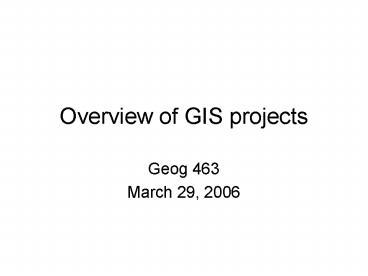Overview of GIS projects - PowerPoint PPT Presentation
Title:
Overview of GIS projects
Description:
Title: Functional approach to GIS design and implementation Author: Sungsoon Hwang Last modified by: Sungsoon Hwang Created Date: 3/29/2006 4:15:13 AM – PowerPoint PPT presentation
Number of Views:239
Avg rating:3.0/5.0
Title: Overview of GIS projects
1
Overview of GIS projects
- Geog 463
- March 29, 2006
2
Outlines
- Scope of GIS projects
- Methodology for GIS implementation plan
- Project management techniques
- Guideline for P1 Needs assessment
3
1. Scope of GIS project
- Single-purpose GIS project
- Initiated to serve one-time objectives
- Departmental GIS project
- A department is responsible for implementing GIS
functionalities - Enterprise GIS project
- Many functions are shared between different
department, thus implementing GIS projects across
multiple departments make sense (MPLIS chapter 16
describes the Enterprise GIS project) - Will benefit from system integration
- Increasing strategic roles of GIS in an
organization - Societal GIS project
- Cost sharing by the society as a whole
4
2. Methodology for GIS implementation plan
- Needs assessment (p. 22)
- Functional needs
- Data needs
- Processing needs
- System requirement (p. 22)
- Hardware/software needs
- Personnel/training needs
- Procedural needs
- Institutional needs
From MPLIS Chapter 16
5
Hierarchy of needs in developing GIS
- See Figure 16-1
- Functional needs ? data/processing needs ?
hardware/software requirement ? personnel needs ?
training needs ? procedurals needs ?
institutional needs ? legal needs
6
Functional needs
- Identify activities which an organization perform
to carry out its mission - Identify all of their organizational units
- List the functions that require maps or other
geographic information - Figure 16-2 list of functions requiring
geographic information (dept function)
7
Data needs
- Geographic information needs inventory
- See Figure 16-3
- Identifies which maps or data are important for
successful completion of each function in the
unit - Describe problems of current data and point out
future needs as well - Map inventory form will help you clarify on
issues involved in map use (Figure 16-5)
8
Processing needs
- Define how the data are to be used to fulfill the
functional needs of the organization - Application definition form (Figure 16-9)
contains data input requirements, processing
requirements, and output products
9
3. Project management techniques
- WBS (Work Breakdown Structure) chart
- Gantt chart
- PERT (Program Evaluation and Review Technique)
10
WBS
A WBS chart displays the structure of a project
showing how a project is organized into summary
(phase) and detail levels.
11
Gantt chart
a tool for displaying the progression of a
project in the form of a specialized chart
12
PERT
A PERT chart displays the tasks in a project
along with the dependencies between these tasks.
Using a PERT chart is a great way to define and
display the dependency relationships that exist
between tasks.
13
Fifteen Project Management Job Functions
- Define scope of project
- Identify stakeholders, decision-makers, and
escalation procedures - Develop detailed task list (work breakdown
structures) - Estimate time requirements
- Develop initial project management flow chart
- Identify required resources and budget
- Evaluate project requirements
- Identify and evaluate risks Prepare contingency
plan - Identify interdependencies
- Identify and track critical milestones
- Participate in project phase review
- Secure needed resources
- Manage the change control process
- Report project status
"Building a Foundation for Tomorrow Skills
Standards for Information Technology," Northwest
Center for Emerging Technologies, Belleview, WA,
1999
14
4. Needs assessment
- Writing points
- Arrange the meeting for needs assessment
15
P1 Needs assessment
- Goal
- What it is to be done
- Research question
- Background
- Client/Stakeholder
- Aspects
- Literature Review
- Objectives
- need to know questions
- Information
- Categories
- nouns of need to know
- questions
- Information
- Products
- Contain information categories
- How to present info?
- Text, tables, maps, graphs
16
Needs Assessment Meeting Objectives
- learn about the clients organization
- determine who are the stakeholders/users
- help the client to understand the capabilities of
GIS - determine what the clients goals or what they
need to know - begin to identify background resources and data
sources































